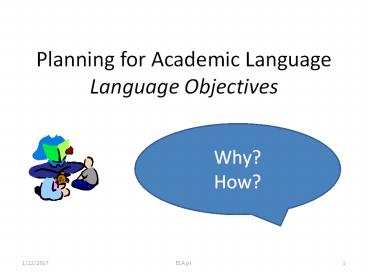Planning for Academic Language Language Objectives - PowerPoint PPT Presentation
1 / 21
Title: Planning for Academic Language Language Objectives
1
Planning for Academic LanguageLanguage Objectives
Why? How?
2
Why is academic language so important?
Lets first begin by thinking about the language
of school.
- Students who master academic language are more
likely to - be successful in academic and professional
settings - Students who do not learn language may
- struggle academically
- be at a higher risk of dropping out of school
3
What is academic language?
- Academic language is
- the language used in the classroom and workplace.
- the language of text.
- the language of assessments.
- the language of academic success.
- the language of power.
It is the language our students need to access.
4
Try This..
- 1. Think about your best friend.
- 2. How would you describe him or her to a
colleague? - Take
a moment to think this through.. - 3. Now think about the 911 tragedy and describe
the events that occurred that day to a colleague.
- Would
you use different words? - Would
your sentence structure change?
You probably use more formal language and you
were careful in the way you phrased the events.
Yes. your register changed, your tenor, field and
mode and audience.
5
Social Language vs. Academic Language
- When using social, or informal, English in daily
conversation, its possible to communicate by
using slang and without using English in a
grammatically correct way. - You can be understood without using
- articles
- prepositions
- sophisticated vocabulary
- pronoun reference
Our students still need social language as a
bridge to academic language.
6
Recognizing Social vs. Academic Language
Informal Formal
Repetition of words Sentences start with and but Use of slang, guy, cool and awesome Variety of words, more sophisticated vocabulary Sentences start with transition words, such as however, moreover, and in addition No slang
Do you feel that we need to explicitly
explain these differences to our students?
7
Academic Language The language needed by
students to do the work in schools. It includes,
for example, discipline-specific vocabulary,
grammar and punctuation, and applications of
rhetorical conventions and devices that are
typical for a content area (e.g., essays, lab
reports, discussions of a controversial issue).
8
What we know.
- Students must learn how to think, act, believe,
speak, listen, read and write in a way that is
expected in school , Freedman and Freedman
(2009) - So we recognize that academic language needs to
be embedded into our content areas.
How do we plan strategically for this in our
content areas?
9
Language Objectives Specify the language
that students need to understand academic content
and to further demonstrate that understanding.
10
Writing a Language Objective
Ask yourself.
- 1. What is the language your English Language
Learner needs to process or produce to
demonstrate their learning? - 2. Content Objectives What?
- 3. Language Objective How?
- .
- 4. How will you provide the opportunity to
practice the language? (Support)
11
When we think of language.
- We think about the functions of language How
will the language be used? - Will the students, ask questions, compare and
contrast, explain etc.? - What are some of the forms of language students
will use when using a particular type of
function content vocabulary, grammatical
structures etc.?
12
Language Functions and Forms
How will the student use the language? (Function ) Domain speaking, listening, reading or writing What grammatical structures and vocabulary of the language will be used? (Forms)
Compare and Contrast Retell Analyze Persuade Synthesis Infer Describe Explain Sequence Syntax and sentence structure Academic vocabulary Grammatical features (parts of speech, tense and mood, subject/verb agreement, adjectives, adverbs etc.)
13
Writing a Language Objective
14
Sentence stems to support intentional language
development
15
Writing a Language Objective
16
Sentence stems to support intentional language
development
17
Function
Domain
Students will identify with labels the parts
of the water cycle by using evaporation,
condensation, and precipitation on a diagram .
Form
Support
Content Objective The student will understand
the parts of the water cycle.
18
Functions for Language Objectives This list can
help you write great Language Objectives for each
language domain.
Listening Speaking Reading Writing
Act, arrange, distinguish, duplicate, categorize, choose, copy, follow directions, identify, indicate, label, listen, match, order, point, recognize, role play, show, sort, tell Agree/disagree, answer, ask, converse, debate, define, describe, discuss, explain, express, give instructions, identify, name, practice, predict, pronounce, rehearse, repeat, rephrase, respond, restate, say steps in a process, share, state, summarize, tell, use vocabulary Discover, distinguish, explore, find, find specific info, identity, infer, interpret, locate, make connections, match preview, predict, read, read aloud, skim Ask and answer, questions, brainstorm, classify, collect, compare, contrast, create, describe, edit, evaluate, explain, illustrate, journal, label, list, order, organize, record, revise, state and justify, opinions, summarize, support, take notes, write
19
Types of Supports
Sensory Supports Visual Supports Group Supports
Real-life objects (realia) Manipulatives Pictures photographs Illustrations, diagrams drawings Magazines newspapers Physical activities Videos films Broadcasts Models figures Charts Graphic organizers Tables Graphs Timelines Number lines In pairs or partners In triads or small groups In a whole group Using cooperative group structures With the Internet (Websites) or software programs In the native language (L1) With mentors
20
Try this..
Supports
21
A thought..
- It is not just words that our
- kids need
- to learn,
- but how to articulate those words,
- read and understand them, and use them in their
writing.




















![Honors Level Course Implementation Guide [English Language Arts] PowerPoint PPT Presentation](https://s3.amazonaws.com/images.powershow.com/7928665.th0.jpg?_=20160626066)










